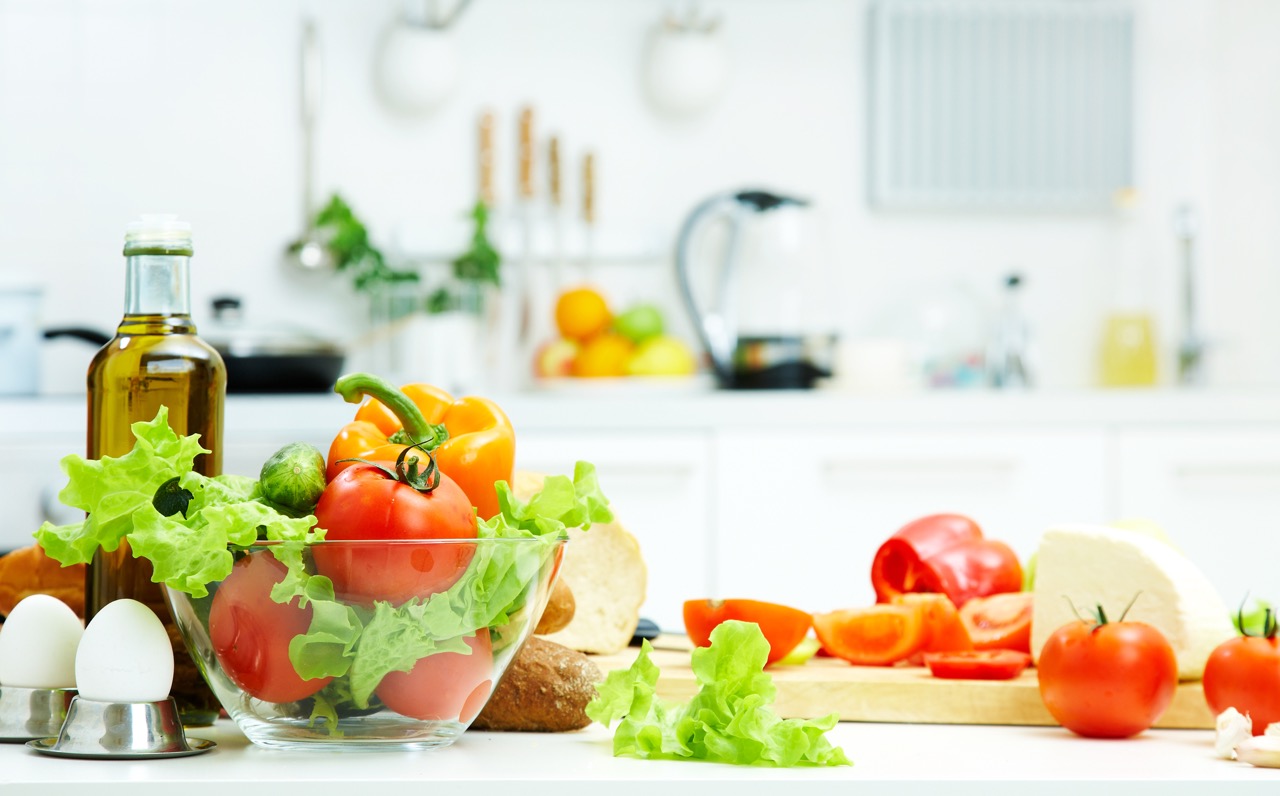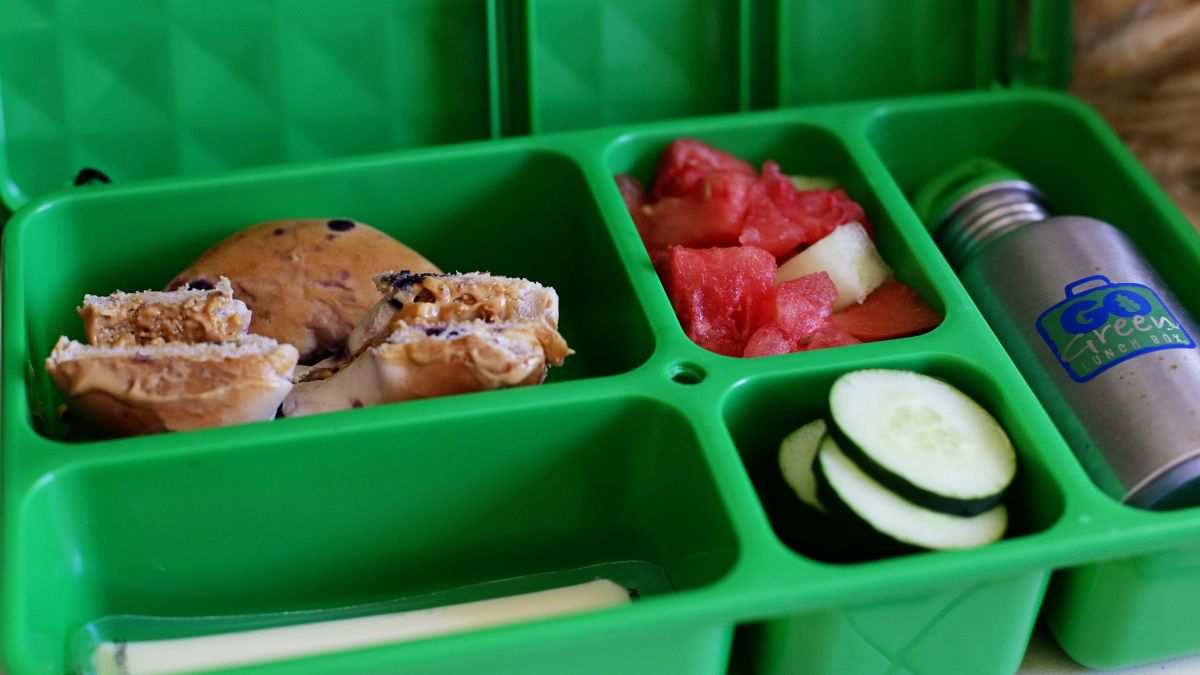Home>Storage Ideas>Kitchen Storage>8 Easy Ways To Go Green With Your Kitchen Routine


Kitchen Storage
8 Easy Ways To Go Green With Your Kitchen Routine
Modified: January 19, 2024
Discover 8 simple and eco-friendly kitchen storage ideas to make your daily routine more sustainable. Implement these practical tips to reduce waste and embrace a green lifestyle for a greener kitchen experience.
(Many of the links in this article redirect to a specific reviewed product. Your purchase of these products through affiliate links helps to generate commission for Storables.com, at no extra cost. Learn more)
Introduction
Welcome to the world of kitchen storage ideas! In today’s article, we will explore creative and practical ways to optimize your kitchen space for efficient storage. Whether you have a small apartment kitchen or a spacious culinary haven, these kitchen storage ideas will help you maximize every inch of your space while keeping it organized and clutter-free.
A well-organized kitchen not only makes cooking a breeze but also enhances the overall aesthetic appeal of your home. With the right storage solutions, you can declutter your countertops, store your kitchen essentials efficiently, and create a functional and visually pleasing environment.
We understand that finding the right storage solutions can be overwhelming, so we’ve compiled a comprehensive list of ideas that cater to different kitchen sizes, layouts, and needs. Get ready to transform your kitchen into a storage haven with these innovative ideas!
Key Takeaways:
- Reduce food waste, use reusable bags, compost scraps, and choose energy-efficient appliances to create an eco-friendly kitchen. Embrace plant-based cooking and skip single-use plastic for a greener lifestyle.
- Make a positive impact by implementing sustainable kitchen practices. From reducing waste to conserving water, every small change contributes to a healthier planet.
Reduce Food Waste
One of the easiest ways to be more eco-friendly in the kitchen is by reducing food waste. According to the Food and Agriculture Organization (FAO), approximately one-third of the food produced globally for human consumption is wasted every year. By implementing a few simple practices, you can help minimize this waste and make a positive impact on the environment.
Start by creating a meal plan and shopping list before heading to the grocery store. This will help you buy only what you need and prevent food from going to waste. When storing food, make sure to properly organize your fridge and pantry, placing older items at the front to encourage their use before they expire.
Invest in airtight containers and labels to store leftovers. Clear containers allow you to easily see what’s inside, reducing the chances of forgetting about them and letting them spoil. And don’t forget about the power of repurposing! Leftover vegetables can be turned into delicious soups or stir-fries, while ripe fruits can be used in smoothies or baked goods.
Getting creative with your leftovers not only helps prevent waste but also adds variety to your meals. If you find yourself with an excess of certain ingredients, consider preserving them through methods like freezing, canning, or pickling. This way, you can enjoy them later and avoid unnecessary waste.
Additionally, consider starting a composting system for your kitchen scraps. Composting not only diverts waste from landfills but also creates nutrient-rich soil that can be used for gardening. There are many different composting systems available, from traditional outdoor compost bins to smaller indoor options like worm composting.
By making a conscious effort to reduce food waste, you can not only contribute to a more sustainable future but also save money by maximizing the use of your groceries.
Use Reusable Grocery Bags
Plastic bags are a major environmental concern as they contribute to pollution and take a significant amount of time to break down in landfills. One easy way to reduce your plastic waste is by using reusable grocery bags when you go shopping.
Invest in a set of durable and reusable shopping bags made from eco-friendly materials such as cotton, canvas, or recycled materials. Keep a few of these bags in your car or near your front door so you’ll always remember to take them with you when you go grocery shopping.
Reusable bags not only reduce the consumption of single-use plastic but also have many other benefits. They are usually sturdier than plastic bags, allowing you to carry more items without the risk of tearing. Many reusable bags also have comfortable handles, making them easier to carry, especially if you have a long walk from the store to your home.
Moreover, some grocery stores offer incentives for customers who bring their own bags. These incentives can range from discounts on your purchase to loyalty points that can be redeemed for future discounts or free products. By using reusable bags, you not only help the environment but also potentially save money and earn rewards.
If you often forget to bring your reusable bags or find yourself in need of an extra bag, opt for paper bags instead of plastic. While paper bags still have an environmental impact, they are biodegradable and can be recycled or composted. Just remember to recycle them or reuse them for other purposes like organizing items in your home.
By incorporating reusable grocery bags into your shopping routine, you can make a significant impact in reducing waste and minimizing your carbon footprint. Plus, you’ll have stylish and durable bags that can be used for various other purposes, such as carrying books, going to the beach, or packing for a picnic.
Compost Food Scraps
Composting is a fantastic way to reduce waste and create nutrient-rich soil for your garden. Instead of throwing food scraps in the trash, consider composting them to give new life to your kitchen waste.
Start by setting up a composting system in your backyard if you have the space. This can be as simple as creating a designated area where you can layer your food scraps with yard waste like leaves or grass clippings. Alternatively, you can opt for a compost bin or a tumbler to accelerate the decomposition process and contain any odors.
If you live in an apartment or don’t have access to outdoor space, don’t worry! There are indoor composting options available, such as worm composting or Bokashi composting. These systems utilize worms or beneficial microorganisms to break down your food waste, and they can be easily managed in a small space.
When it comes to composting, it’s important to know what can and cannot be composted. Fruit and vegetable scraps, coffee grounds, eggshells, tea bags, and yard waste are all excellent materials for composting. However, avoid composting meat, dairy, oily foods, or any items treated with chemicals or pesticides, as they can attract pests or create an unhealthy compost pile.
Keep a small compost bin or container in your kitchen to collect food scraps throughout the day. Empty it into your outdoor composting system or take it to a local composting facility regularly. Remember to turn and water your compost pile to encourage decomposition and avoid any unpleasant odors.
Composting not only diverts organic waste from landfills but also reduces the need for chemical fertilizers in your garden. By using your homemade compost, you can improve soil quality, retain moisture, and promote the growth of healthy plants.
Whether you have a small apartment or a sprawling garden, composting is a sustainable practice that allows you to give back to the earth and reduce your environmental impact.
Opt for Locally Sourced Ingredients
Choosing locally sourced ingredients is not only beneficial for your health but also for the environment. When you buy locally, you support local farmers and reduce the carbon footprint associated with transportation and shipping of food.
Local produce is often fresher, as it doesn’t need to travel long distances to reach your plate. This means that it retains more nutrients and flavors compared to produce that has been shipped from far away. Additionally, buying local helps to preserve genetic diversity, as smaller-scale farmers are more likely to grow heirloom and unique varieties of fruits and vegetables.
To start incorporating locally sourced ingredients into your kitchen routine, visit your nearest farmer’s market or join a Community Supported Agriculture (CSA) program. Farmer’s markets are a great place to connect directly with local farmers, learn about their practices, and discover a wide range of seasonal produce.
CSA programs, on the other hand, allow you to subscribe to receive a weekly or monthly box of fresh produce directly from local farmers. This not only ensures a steady supply of seasonal ingredients but also provides an opportunity to try new fruits and vegetables that you might not find in traditional grocery stores.
When purchasing locally sourced ingredients, take the time to ask the farmers about their farming practices. Many small-scale farmers follow organic or sustainable farming methods, which are not only better for the environment but also avoid the use of harmful pesticides and synthetic fertilizers.
Not only does cooking with locally sourced ingredients support local communities and foster a connection with where your food comes from, but it also encourages a more sustainable food system. By reducing the distance between farm and fork, you’re helping to minimize the use of fossil fuels and decrease greenhouse gas emissions associated with long-distance transportation.
So, next time you plan your meals, consider reaching out to local farmers and discovering the benefits of cooking with fresh, locally sourced ingredients. Your taste buds and the environment will thank you!
Consider using reusable containers and bags for storing and transporting food, rather than single-use plastic bags and wraps. This simple switch can greatly reduce your kitchen’s environmental impact.
Choose Energy-Efficient Appliances
When it comes to creating a greener kitchen, choosing energy-efficient appliances is a key consideration. Energy-efficient appliances not only reduce your carbon footprint but also save you money on your utility bills in the long run.
Start by looking for kitchen appliances with the ENERGY STAR label. ENERGY STAR-certified appliances meet strict energy efficiency requirements set by the Environmental Protection Agency (EPA). These appliances are designed to consume less energy while still providing the same level of performance as their non-certified counterparts.
One of the biggest energy consumers in the kitchen is the refrigerator. When shopping for a new fridge, choose a model that is appropriately sized for your needs. A smaller fridge requires less energy to cool, so consider your storage needs and opt for the smallest size that will accommodate them. Look for features like adjustable temperature settings and advanced insulation technology to further increase energy efficiency.
Another energy-guzzler in the kitchen is the dishwasher. Look for dishwashers that offer energy-saving modes, such as shorter cycles or air-drying options. Energy-efficient dishwashers use less water and energy to clean your dishes effectively, helping to conserve resources.
When it comes to cooking, consider using energy-efficient appliances like induction cooktops. Induction cooktops use electromagnetic technology to heat only the pan and its contents, making them more energy efficient compared to traditional stovetops. Additionally, invest in convection ovens that circulate hot air more efficiently, reducing cooking time and energy usage.
Don’t forget about smaller kitchen appliances like microwaves, toasters, and blenders. Look for models that have energy-saving features and timers that automatically power off when not in use. Unplugging these appliances when they’re not in use can also help save energy and reduce your utility bills.
Remember, energy-efficient appliances not only benefit the environment, but they can also improve your cooking experience by providing better performance and functionality. Keep in mind that the initial cost of energy-efficient appliances may be higher, but the long-term savings in energy bills make them a worthwhile investment.
By choosing energy-efficient appliances, you can reduce your kitchen’s energy consumption and contribute to a more sustainable future.
Conserve Water
Conserving water in the kitchen is not only essential for preserving this precious resource but also for reducing your water bill. By making a few simple changes to your kitchen routine, you can significantly reduce water waste and contribute to a more sustainable future.
Start by fixing any leaks in your kitchen faucets. A dripping faucet may seem insignificant, but it can waste a significant amount of water over time. Check for leaks regularly and repair or replace any faulty faucets to prevent unnecessary water waste.
When washing dishes, fill the sink or a basin with soapy water instead of running the tap continuously. This not only saves water but also allows you to reuse the soapy water for multiple dishes before rinsing. Alternatively, use a dishwasher to wash your dishes, as it typically uses less water compared to handwashing, especially if you wait until it’s full before running a cycle.
When using the dishwasher, use the eco-friendly or energy-saving mode whenever possible. These modes use less water and energy while still effectively cleaning your dishes. Additionally, try scraping off excess food scraps from your dishes instead of rinsing them under running water before loading them into the dishwasher.
When it comes to cooking, be mindful of the amount of water you use. Instead of letting water run while waiting for it to heat up, capture that cold water in a container and use it for watering plants or cleaning. Only use the amount of water necessary for cooking, and consider steaming vegetables instead of boiling them to minimize water usage.
Installing low-flow faucet aerators and showerheads in your kitchen can also help conserve water. These devices mix air with the water stream, reducing water usage while maintaining adequate pressure. They are easy to install and can help you save gallons of water each day.
Finally, consider collecting and utilizing rainwater for tasks that don’t require potable water, such as watering plants or cleaning. Place a barrel or container outside to collect rainwater from your roof and use it as a free and sustainable water source.
By incorporating these water-saving practices into your kitchen routine, you can make a significant impact on conserving water and reducing your environmental footprint.
Skip Single-Use Plastic
Reducing the use of single-use plastic in the kitchen is an important step towards a more sustainable lifestyle. Single-use plastics contribute to pollution and take hundreds of years to decompose, leading to adverse effects on the environment, wildlife, and human health.
One of the easiest ways to skip single-use plastic in the kitchen is by using reusable alternatives. Invest in reusable water bottles, coffee cups, and travel mugs to replace disposable plastic bottles and cups. Bring these items with you when you’re on the go or at work to avoid relying on single-use plastics.
Plastic bags are another major contributor to environmental pollution. Instead of using plastic bags for storing food or packing lunches, opt for reusable silicone or fabric bags. These bags are easily washable and can be used repeatedly, significantly reducing the amount of plastic waste generated in your kitchen.
When it comes to food storage, avoid using plastic wrap or aluminum foil. Instead, choose reusable food storage containers made of glass or stainless steel. These containers are durable, non-toxic, and can be used for storing leftovers, snacks, and meal preparations.
Avoid using single-use plastic utensils and straws by switching to reusable alternatives. Carry a set of stainless steel or bamboo utensils with you, so you can refuse plastic cutlery when dining out or getting takeout. Opt for stainless steel or glass straws for sipping your favorite beverages without contributing to the plastic pollution problem.
To reduce reliance on single-use plastic packaging, try to buy in bulk whenever possible. Purchase staple items like grains, nuts, and spices from bulk food stores using your own reusable containers or bags. This not only reduces plastic waste but also saves you money in the long run.
Additionally, be mindful of the products you buy and choose ones that are packaged in minimal or eco-friendly packaging. Look for brands that prioritize sustainability by using compostable or recycled materials for their packaging or offer refillable options for cleaning and personal care products.
By consciously avoiding single-use plastic in the kitchen, you can make a significant impact in reducing plastic waste and promoting a more sustainable and plastic-free environment.
Embrace Plant-Based Cooking
Embracing plant-based cooking is not only a healthy choice but also a sustainable one. Plant-based diets have a lower carbon footprint compared to diets rich in animal products. Incorporating more fruits, vegetables, grains, and legumes into your meals can have a positive impact on both your health and the environment.
Start by incorporating more plant-based meals into your weekly menu. Aim for at least a few meatless days each week and experiment with new vegetarian or vegan recipes. There is a wide variety of delicious plant-based dishes to explore, from hearty vegetable stews to vibrant grain bowls and protein-packed legume salads.
When shopping for ingredients, choose organic and locally sourced produce whenever possible. Organic farming practices avoid the use of harmful chemicals and pesticides, which can have detrimental effects on the environment and human health. Buying local reduces the carbon footprint associated with transportation and supports local farmers and food producers.
Another way to embrace plant-based cooking is to reduce food waste. Use your creativity to transform leftover vegetables into soups, stir-fries, or veggie-packed omelets. Overripe fruits can be used in smoothies, baked goods, or turned into homemade jams and sauces. Don’t be afraid to get adventurous in the kitchen and make the most out of every ingredient.
Consider growing your own herbs, vegetables, and fruits, even if you have limited space. You can start with a small herb garden on your windowsill or balcony, or you can try vertical gardening for larger plants. Not only does this provide you with fresh and organic produce, but it also connects you with the process of food production and instills a sense of appreciation for nature.
By embracing plant-based cooking, you reduce the demand for animal products, which in turn reduces greenhouse gas emissions, land degradation, and water pollution associated with animal agriculture. Plant-based diets also tend to be rich in fiber, vitamins, and antioxidants, promoting better health and overall wellbeing.
As you transition to a plant-based diet, don’t forget to explore different flavors and cuisines. Use herbs, spices, and condiments to add depth and complexity to your plant-based meals. Experiment with different cooking methods like grilling, roasting, steaming, or stir-frying to create delicious and nourishing dishes.
Remember, embracing plant-based cooking is not about perfect adherence, but rather about making conscious choices to incorporate more plant-based ingredients into your meals. Small changes in your everyday cooking habits can have a big impact on your health, the environment, and the well-being of animals.
Conclusion
Congratulations on exploring these eight easy ways to go green with your kitchen routine! By implementing these practices, you can make a significant impact on the environment while also creating a more organized and efficient kitchen space.
Reducing food waste, using reusable grocery bags, composting food scraps, opting for locally sourced ingredients, choosing energy-efficient appliances, conserving water, skipping single-use plastic, and embracing plant-based cooking are all steps towards a more sustainable and eco-friendly lifestyle.
Each of these practices has its own benefits, from saving money on utility bills to supporting local farmers, reducing greenhouse gas emissions, and improving your overall health. By incorporating these habits into your daily routine, you are contributing to a healthier planet for future generations.
Remember, sustainability is a journey, and every small change adds up to make a significant difference. So, start by implementing one or two of these ideas and gradually incorporate more as you become more comfortable with sustainable practices.
Lastly, don’t forget to spread the word and inspire others to adopt these green kitchen habits. Share your knowledge and experiences with friends, family, and colleagues, and encourage them to join you on the path towards a more sustainable and environmentally conscious lifestyle.
Together, we can make a positive impact and create a greener future, one kitchen at a time.
Frequently Asked Questions about 8 Easy Ways To Go Green With Your Kitchen Routine
Was this page helpful?
At Storables.com, we guarantee accurate and reliable information. Our content, validated by Expert Board Contributors, is crafted following stringent Editorial Policies. We're committed to providing you with well-researched, expert-backed insights for all your informational needs.














0 thoughts on “8 Easy Ways To Go Green With Your Kitchen Routine”